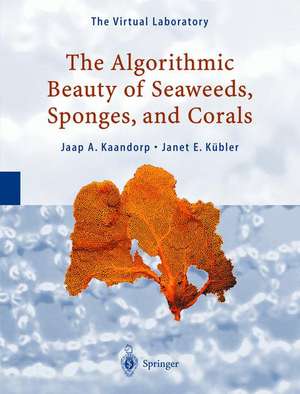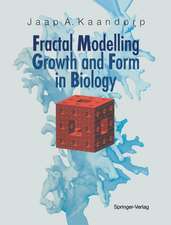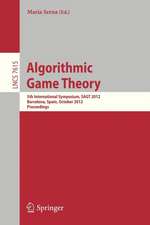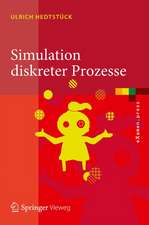The Algorithmic Beauty of Seaweeds, Sponges and Corals: The Virtual Laboratory
Autor Jaap A. Kaandorp, Janet E. Kübleren Limba Engleză Hardback – 28 sep 2001
| Toate formatele și edițiile | Preț | Express |
|---|---|---|
| Paperback (1) | 1160.40 lei 6-8 săpt. | |
| Springer Berlin, Heidelberg – 19 oct 2010 | 1160.40 lei 6-8 săpt. | |
| Hardback (1) | 969.73 lei 38-44 zile | |
| Springer Berlin, Heidelberg – 28 sep 2001 | 969.73 lei 38-44 zile |
Preț: 969.73 lei
Preț vechi: 1212.16 lei
-20% Nou
Puncte Express: 1455
Preț estimativ în valută:
185.58€ • 201.51$ • 155.89£
185.58€ • 201.51$ • 155.89£
Carte tipărită la comandă
Livrare economică 18-24 aprilie
Preluare comenzi: 021 569.72.76
Specificații
ISBN-13: 9783540677000
ISBN-10: 3540677003
Pagini: 212
Ilustrații: XV, 193 p. 138 illus., 51 illus. in color.
Dimensiuni: 210 x 277 x 19 mm
Greutate: 0.97 kg
Ediția:2001
Editura: Springer Berlin, Heidelberg
Colecția Springer
Seria The Virtual Laboratory
Locul publicării:Berlin, Heidelberg, Germany
ISBN-10: 3540677003
Pagini: 212
Ilustrații: XV, 193 p. 138 illus., 51 illus. in color.
Dimensiuni: 210 x 277 x 19 mm
Greutate: 0.97 kg
Ediția:2001
Editura: Springer Berlin, Heidelberg
Colecția Springer
Seria The Virtual Laboratory
Locul publicării:Berlin, Heidelberg, Germany
Public țintă
ResearchCuprins
1 Introduction.- 2 Environmentally Driven Plasticity.- 3 Measuring Growth and Form.- 4 Simulating Growth and Form.- 5 Verifying Models.- 6 Applications.- 7 Epilogue.- References.
Recenzii
From the reviews:
"Sessile marine organisms, like sponges or corals, are often modular organisms, typically built of repeated units, the modules. … Improved computing methods have made it possible to simulate the growth of such organisms … . This volume is the outcome of a 1999 conference. It is mainly devoted to the interaction of biology and computing. Many figures confronting photos of live animals with computer generated simulations give a good impression for the non-specialist." (Benno Artmann, Zentralblatt MATH, Vol. 1007, 2003)
"The purpose of this book … is to ‘provide an overview of how simulation models can provide insights into the growth and forms of seaweeds, sponges, corals and other marine sessile organisms. … the text as a whole has coherence and balance. It is beautifully, if sometimes eccentrically, illustrated with photographs, drawings and computer simulations. It provides a clear and much-needed summary of the state of the art in this difficult but important area of biological simulation that will appeal to the specialist." (Michael Whitfield, Times Higher Education Supplement, November, 2002)
"Jaap Kaandorp and Janet Kübler’s book The Algorithmic Beauty of Seaweeds, Sponges and Corals covers the modelling of the growth and form of some organisms. Lots of detail is provided for the biology … . there is enough information to encourage investigations – and the many wonderful illustrations help to spur on the reader." (Andrew Bowler, New Scientist, March, 2002)
"Sessile marine organisms, like sponges or corals, are often modular organisms, typically built of repeated units, the modules. … Improved computing methods have made it possible to simulate the growth of such organisms … . This volume is the outcome of a 1999 conference. It is mainly devoted to the interaction of biology and computing. Many figures confronting photos of live animals with computer generated simulations give a good impression for the non-specialist." (Benno Artmann, Zentralblatt MATH, Vol. 1007, 2003)
"The purpose of this book … is to ‘provide an overview of how simulation models can provide insights into the growth and forms of seaweeds, sponges, corals and other marine sessile organisms. … the text as a whole has coherence and balance. It is beautifully, if sometimes eccentrically, illustrated with photographs, drawings and computer simulations. It provides a clear and much-needed summary of the state of the art in this difficult but important area of biological simulation that will appeal to the specialist." (Michael Whitfield, Times Higher Education Supplement, November, 2002)
"Jaap Kaandorp and Janet Kübler’s book The Algorithmic Beauty of Seaweeds, Sponges and Corals covers the modelling of the growth and form of some organisms. Lots of detail is provided for the biology … . there is enough information to encourage investigations – and the many wonderful illustrations help to spur on the reader." (Andrew Bowler, New Scientist, March, 2002)
Textul de pe ultima copertă
This book gives a state-of-the-art overview of modeling growth and form of marine sessile organisms - such as stromatolites, algae, and metazoans including stony corals, hydrocorals, octocorals, and sponges -, using large-scale computing techniques, scientific visualization, methods for analyzing 2D and 3D forms, and particle-based modeling techniques. It originates from the workshop on Modeling Growth and Form of Marine Sessile Organisms, held at the National Center for Ecological Analysis and Synthesis, Santa Barbara, California, August 1999. Experts from various disciplines including developmental biology, ecology, computer science, physics and mathematics, who have research interests in modeling the development of these organisms have been invited to contribute. The book describes all the steps required to develop and experimentally validate morphological models including collecting biological information and methods for specifying and comparing forms. Examples are given of how models are currently being applied to simulate growth and form of marine sessile organisms. Potential applications of growth models and morphological analyses in modern and paleo-bio-monitoring, the detection of environmental change, and the conservation and restoration of marine ecosystems and aquaculture are addressed. The combination of simulation models with laboratory and field experiments provides a powerful tool to obtain insights on how the growth forms of marine organisms emerge from physical, genetic and environmental influences.
Caracteristici
State of the art of modeling and simulating growth and form of marine sessile organisms using large-scale computing, scientific visualization, methods for analyzing 2D and 3D forms, and particle-based modeling techniques With contributions of experts from various disciplines including developmental biology, ecology, computer science, physics, and mathematics Includes supplementary material: sn.pub/extras














